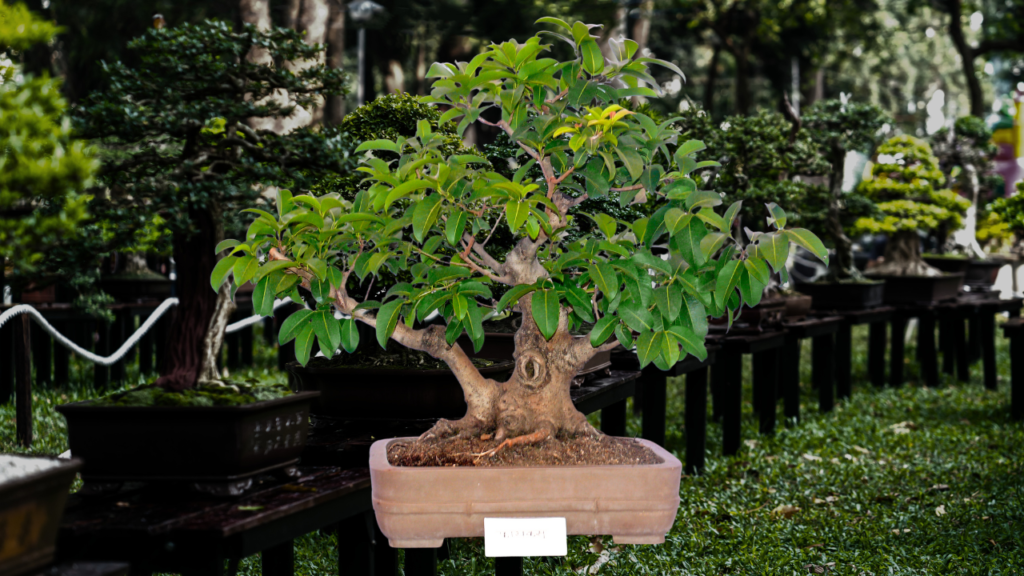Ficus trees, often referred to as fig trees, are one of the most popular choices for bonsai enthusiasts. Their resilience, versatility, and beautiful structures make them an excellent choice, especially for beginners. Here’s a comprehensive care guide to ensure your Ficus bonsai thrives:
| Ficus Bonsai Quick Reference | |
|---|---|
| Attribute | Information |
| 🌾Plant Type | Mostly evergreen trees, shrubs, or climbing plants |
| ☀️Sun Exposure | Requires a lot of light, preferably full sunlight. Should not be placed in a shady location. |
| 🌡️Temperature | Does not endure frosty conditions. Can be kept outside in summer if temperatures are above 60°F (15°C). |
| 💧Humidity | Can endure low humidity due to waxy leaves but prefers higher humidity. Needs extremely high humidity to develop aerial roots. |
| 🍂Leaf Characteristics | Special pointed tips from which rainwater drips off. Size varies between 1–20″ (2-50cm). |
| 🌲Popular Varieties | Ficus Retusa, Microcarpa, Tigerbark, Willow leaf, Golden Gate, Religiosa, Benjamina, Taiwan, and Ficus Ginseng. |
| 🍁Fruits | Can be yellow, green, red, or purple-blue. Only specialized pollinating fig wasps can pollinate the hidden flowers. |
| 🌎Native Area | Found on every continent in tropical regions. |
1. Positioning and Light:
- Sunlight: Ficus trees love sunlight. Place your bonsai in a location where it can receive indirect sunlight for most of the day. If you’re keeping it indoors, a south-facing windowsill is ideal.
- Indoor vs. Outdoor: While Ficus can be kept outdoors in warmer months, they’re primarily indoor bonsai. If temperatures drop below 60°F (15°C), it’s best to bring them inside.
2. Watering:
- Frequency: Ficus prefers consistent moisture. Water when the topsoil feels slightly dry to the touch. Overwatering can lead to root rot, while underwatering can cause leaf drop.
- Method: Use a watering can with a fine nozzle to ensure even watering. Water from the top and allow excess water to drain out.
3. Humidity:
- Ficus trees thrive in higher humidity. If your home is dry, consider placing a humidity tray beneath the pot or occasionally misting the leaves.
- Grouping several plants together can also increase humidity around your Ficus.
4. Soil and Fertilizing:
- Soil: Use a well-draining bonsai soil mix. A mix of akadama, pumice, and organic potting compost in a 1:1:1 ratio works well.
- Fertilizing: During the growing season (spring to early autumn), feed your Ficus with a balanced liquid bonsai fertilizer every two weeks. Reduce feeding in winter.
5. Pruning and Shaping:
- Pruning: Regularly prune your Ficus to maintain its shape. Focus on removing dead or unwanted growth.
- Wiring: Ficus branches are flexible and respond well to wiring. Wire can be applied year-round but monitor regularly to ensure the wire doesn’t cut into the bark.
6. Repotting:
- Ficus bonsai should be repotted every 1-3 years for younger trees and every 3-5 years for older ones.
- When repotting, trim back a third of the root ball to encourage new growth.
7. Pests and Diseases:
- Ficus is relatively hardy but can be susceptible to pests like aphids, mealybugs, and scale. Regularly inspect your tree and treat any infestations promptly.
- Use a mild insecticidal soap or neem oil as a preventative measure.
8. Common Issues:
- Leaf Drop: A common issue, especially when the tree is moved to a new location or experiences a change in conditions. Ensure consistent care, and the tree will usually recover.
- Yellowing Leaves: Often a sign of overwatering. Check the soil moisture and adjust your watering routine accordingly.
Bonsai Care Essentials
Conclusion:
Ficus bonsai trees are a joy to care for, offering lush greenery and a connection to nature. With consistent care, attention to its needs, and regular maintenance, your Ficus bonsai will thrive and bring you years of enjoyment.
